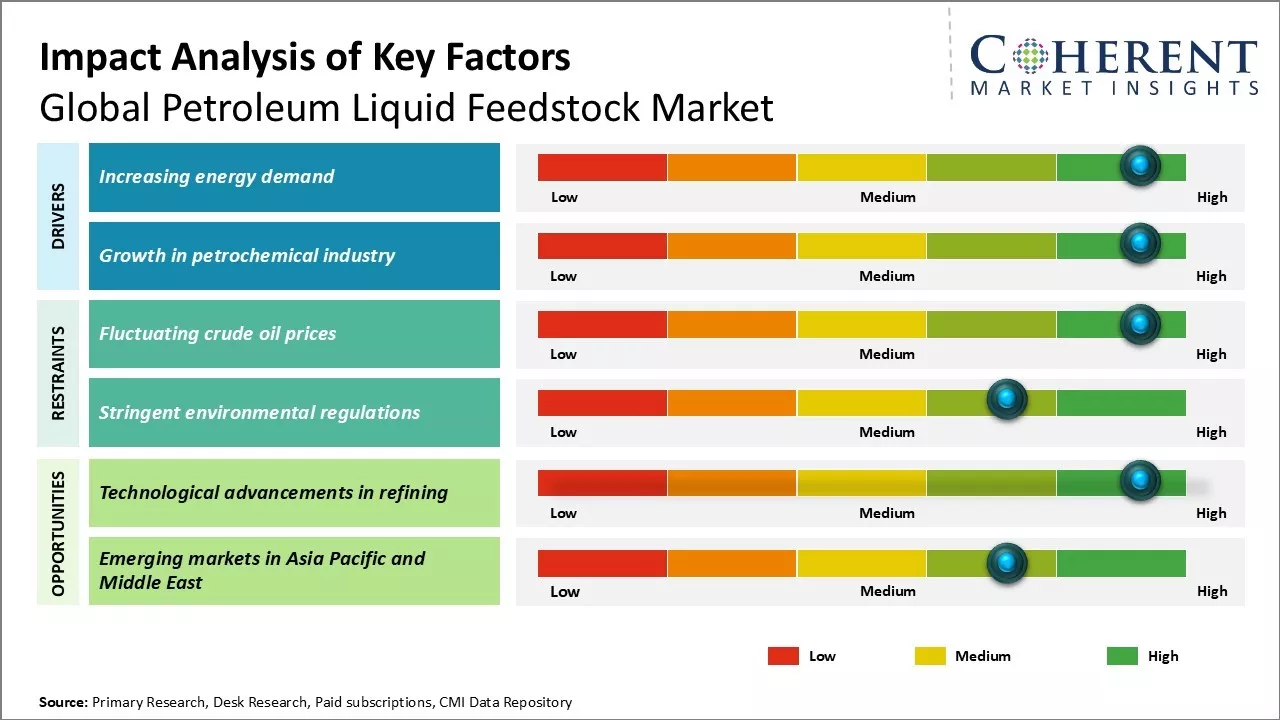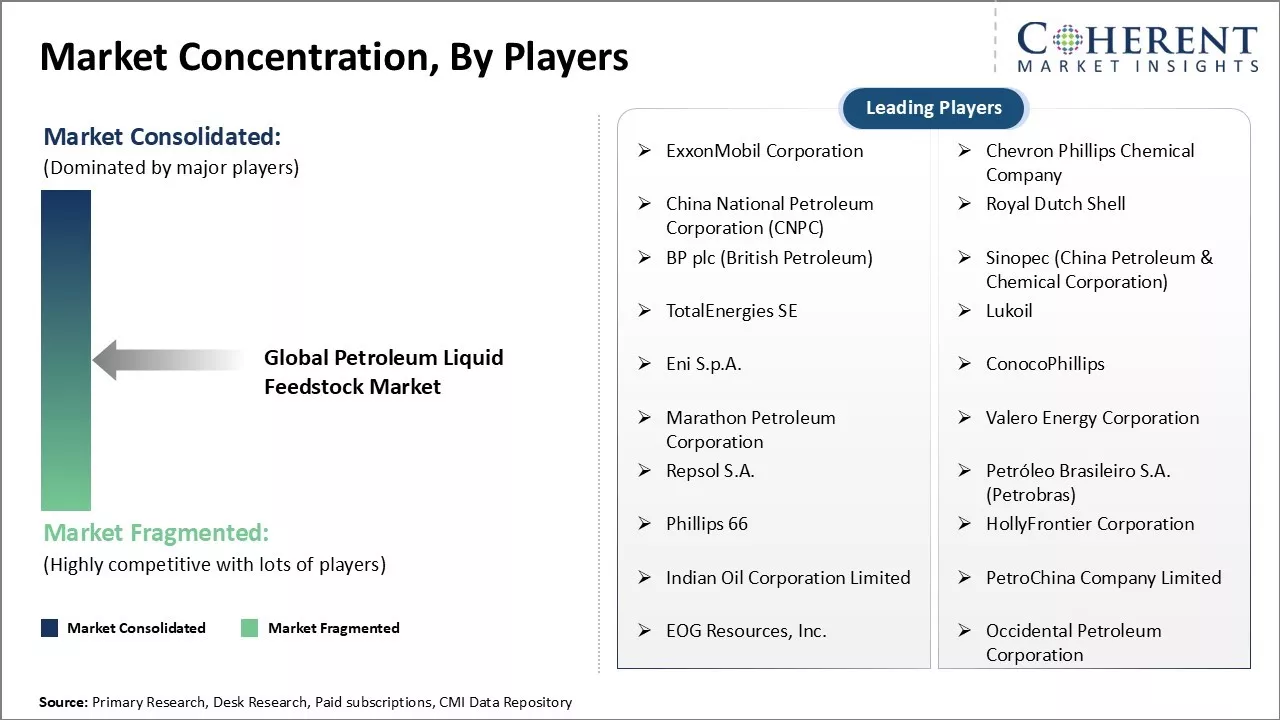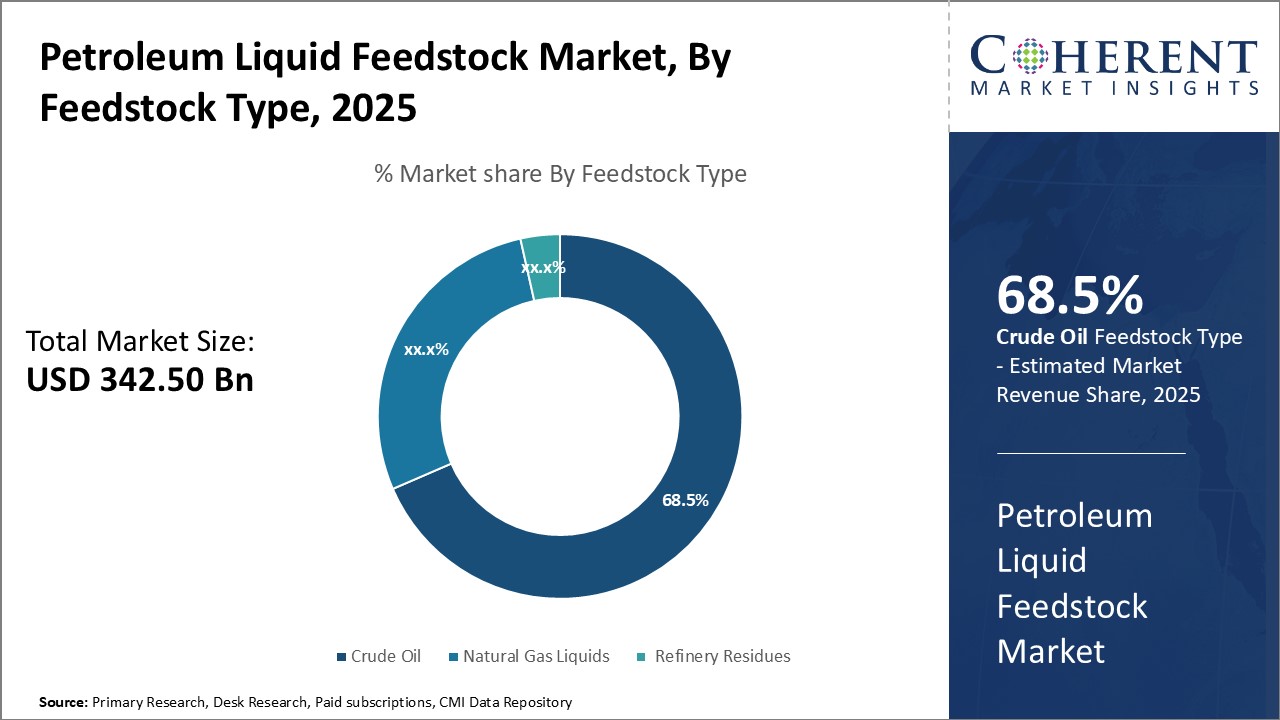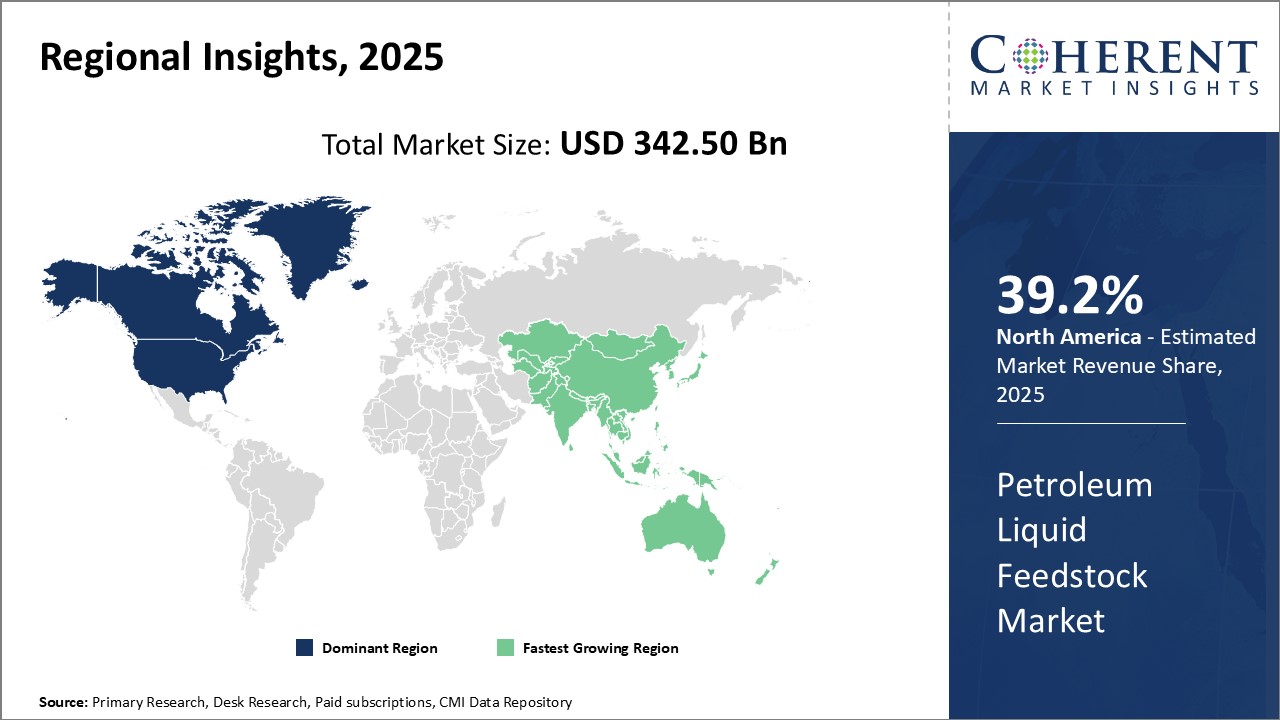Petroleum Liquid Feedstock Market Size and Trends
The global petroleum liquid feedstock market is estimated to be valued at USD 342.50 Billion in 2025 and is expected to reach USD 472.69 Billion by 2032, exhibiting a compound annual growth rate (CAGR) of 4.7% from 2025 to 2032.

Discover market dynamics shaping the industry: Download Free Sample
Increasing demand for petrochemicals from major end-use industries, such as plastic, rubber, and transportation, is driving significant growth in the petroleum liquid feedstock market.
Market Driver - Increasing energy demand
As the global population and economies continue to grow rapidly, the demand for energy has seen a corresponding rise. With large developing nations like China and India experiencing sustained high rates of economic growth and urbanization in recent decades, their consumption of energy has skyrocketed to fuel industries and meet the needs of a growing middle class. Petroleum liquids have remained a key source of energy globally to power vehicles, generate electricity, fuel airplanes and ships, and serve as feedstock for the petrochemical industry. Even with the increasing adoption of renewable energy and electric vehicles in some developed markets, the overall energy needs, especially in developing regions, are expected to remain heavily reliant on petroleum liquids in the coming years.
The transportation sector alone has witnessed massive growth worldwide led by a boom in vehicle ownership and usage, particularly in the middle classes of developing nations. Liquid fuels derived from crude oil, such as gasoline and diesel, continue to dominate as they provide high energy density and convenience of use in vehicles. With personal mobility needs growing rapidly in tandem with economic development, the demand for gasoline and diesel is projected to increase substantially. Petroleum refineries specializing in producing liquid transportation fuels are ramping up operations to satisfy this surging demand. Experts project global consumption of petroleum liquids for transportation will witness sustained growth over the next couple of decades, driven primarily by the developing world.
Market Concentration and Competitive Landscape

Get actionable strategies to beat competition: Download Free Sample
Growth in petrochemical industry
The petrochemical industry has emerged as a major driver of global growth in demand for petroleum liquid feedstock. Petrochemicals form the building blocks for innumerable everyday products ranging from plastics, fibers, solvents to rubber and lubricants. Rapid industrialization and rising disposable incomes have led to tremendous increases in the consumption of petrochemical products worldwide. In particular, the demand for plastics has grown exponentially given its versatility, light weight, and durability which lends it use across many manufacturing industries as well as packaging. Many developing economies are also industrializing their manufacturing sectors aggressively and expanding their usage of plastics.
Given its ease of conversion to petrochemical feedstock through cracking and other refining processes, crude oil has served as the primary raw material supporting the petrochemical industry's growth. With rising requirements for petrochemicals and their extensive suite of derivative goods, petroleum refineries specializing in generating naphtha, aromatics and other petrochemical grade liquid feeds are undergoing capacity additions. Many national oil companies as well as global majors have made large investments in the construction of grassroot petrochemical units integrated with refineries. They aim to capitalize on projected high future petrochemical demand driven by Asia and other developing economies undergoing industrialization. The synergies between refining and petrochemical operations also offer attractive margins. Hence, growth in petrochemical consumption is a major driver propping up global demand for petroleum liquid feedstock.
Key Takeaways from Analyst:
The global petroleum liquid feedstock market is expected to witness stable growth over the next five years. The market is driven by rising demand for petrochemicals and plastics from the construction and automotive industries. North America currently dominates the market owing to the large chemical industry presence and growing manufacturing sector in region. North America is also a major market boosted by shale gas extraction and investment in refineries. However, volatility in crude oil prices remains a key restraint along with stringent environmental regulations curbing fossil fuel usage in some countries.
New petrochemical hubs are emerging across the Middle East and Asia as companies look to leverage cheap feedstock availability and expand operations closer to growing end-use markets. Capacity additions in complex refineries that provide more opportunities for secondary conversion of refinery off-cuts into petrochemicals will support market growth. Adoption of technologies like petrochemical integration is expected to boost feedstock utilization and productivity. Feedstock flexibility through investments in pipelines, import/export facilities provide an opportunity to access diverse crude slates.
Sustainable chemistry and the rise of bio-based chemicals and recycled feedstock also pose a threat to traditional petroleum-based routes over the long term. However, the market is expected to retain its dominance given the current scale and infrastructure dependence.
Market Challenge - Fluctuating crude oil prices
One of the key challenges faced by the global petroleum liquid feedstock market is the fluctuating crude oil prices in the international market. The prices of crude oil are highly volatile and depend on various global economic and geopolitical factors. When crude oil prices increase, it negatively impacts the profit margins and cash flows of refineries and petrochemical companies that use crude oil and its distillates as feedstock. High feedstock costs reduce the competitiveness of refineries and force them to purchase less crude oil from producers. Geopolitical tensions and uncertainty in major oil producing regions like the Middle East also contribute to the volatility in oil prices from time to time. The frequent ups and downs in crude oil prices make demand forecasting and capital investment planning very challenging for stakeholders in this market. They have to constantly adapt their business strategies based on unpredictable changes in crude cost, which is the major raw material component. This price variance poses financial and operating risks, thereby acting as a key limiting factor for the stable growth of the global petroleum liquid feedstock market.
Market Opportunity - Technological advancements in refining
One of the key opportunities for the global petroleum liquid feedstock market is the technological advancements happening in the refining industry. Research and development activities are continuously aimed at improving refining processes to extract more valuable products from crude oil. Techniques like fluid catalytic cracking are being enhanced to increase the yields of high-value petrochemical feedstocks and transportation fuels. Refineries across major markets are investing in innovative technologies like delayed coking that help upgrade heavier crude oils into valuable petroleum products. Adoption of advanced process controls and digitalization is also optimizing refinery operations. New fractionation methods are allowing refineries to better customize their product slates based on prevailing market demands. Such technological advancements are lowering production costs and enabling refineries to efficiently process diverse types of crude oils. They are helping stakeholders in this market to maximize resource utilization and profitability even during times of fluctuating crude prices.

Discover high revenue pocket segments and roadmap to it: Download Free Sample
Insights by Feedstock Type: Crude oil dominates as the premier petroleum feedstock due to ubiquity in refining
Crude oil reigns supreme as the dominant feedstock type in the global petroleum liquid feedstock market owing to its ubiquitous role in oil refining worldwide. As the most naturally abundant and lowest-cost option, crude oil possesses unique properties that make it highly preferable for downstream processing compared to other alternatives like natural gas liquids. Its consistent molecular composition and energy density characteristics translate to stable and efficient refining yields.
Refineries are specifically engineered and optimized over decades of operation to receive crude oil as feed and efficiently convert it through the distillation and cracking processes into the full suite of required refined products in their standard distributions. Retooling or building new facilities to handle varying alternative feedstocks on a large scale would require massive capital investments that are unlikely to offer sufficient returns. Refiners have also achieved tremendous expertise in evaluating different crude streams and blending them to obtain desired product outcomes.
Geography remains another key factor as most crude oil reserves and production are located near consumption centers or export terminals with established infrastructure for marine transport. This avoids costly long-distance shipping of alternatives like natural gas in liquefied or compressed forms. The mature crude trade further enables just-in-time supply chain management and reliable access. Regional crude variations also ensure security of supply through diversification compared to reliance on fewer compressed natural gas sources.
Overall, crude oil's dominance in refining owes to the incredible scale, optimization, and sunk costs invested over decades into supporting energy systems tailored predominantly around this single primary feedstock. Switching to alternatives faces considerable economic and technical hurdles that defend crude oil's dominant market share amid the global transition to new energy sources.
Insights by application: Gasoline production leverages refining infrastructure optimized for gasoline yields
Among petroleum product applications, gasoline production harnesses the refining industry's intrinsic optimization for high distillate yields to carve out the largest market share. Global fuel specifications require gasoline as a key blend stock and most refineries are designed primarily to maximize valuable high-volatility gasoline production from crude distillation. Modern processes like catalytic and thermal cracking also preferentially produce gasoline and lighter distillates over heavier fractions due to economic drivers.
Refinery configuration and catalyst selection influence yield distributions, directing disproportionately more feedstock volume towards gasoline than other products. Configuration remains challenging to reoptimize for diesel or petrochemicals preferentially without compromising overall refining economics. Regional gasoline specifications further enlist unique refining assets and expertise suited to meet local demands. Growing private vehicle ownership worldwide also fuels extensive gasoline infrastructure and habituation difficult to transition away from.
As a transport fuel, gasoline leverages vast distribution networks of pipelines, ships, and tank trucks facilitating just-in-time deliveries from refineries to thousands of retail stations. Stations require low capital expenditure compared to alternatives like electricity or hydrogen. Fuel divestment remains challenging without coordinated new infrastructure investment. The incumbent gasoline production, distribution, and usage model compound to defend its dominant market share in global petroleum applications. Rival low-carbon options face substantial barriers replacing this entrenched liquid fuels infrastructure optimized for high gasoline yields.
Regional Insights

Need a Different Region or Segment? Download Free Sample
North America has established itself as the dominant region in the global petroleum liquid feedstock market with 39.2% share in 2025. With the U.S. as one of the largest producers and consumers of crude oil and natural gas globally, North America accounts for sizeable production and consumption of petroleum liquid feedstocks. Major oil producing regions like Permian Basin, Eagle Ford shale, and Bakken shale have enabled the U.S. to meet domestic needs while exporting excess supplies. Additionally, the region is home to leading refining companies that process crude oil into petroleum products. Due to well-developed refined petroleum product pipeline infrastructure as well as strategic petroleum reserve facilities, North America enjoys strong supply reliability.
Asia Pacific has emerged as the fastest growing regional market for petroleum liquid feedstock. Rapid industrialization and urbanization have increased energy demands, making countries like China and India highly reliant on imported crude oil to meet their needs. China, the world's second largest crude oil consumer after the U.S., imports around 70.5% of its crude oil requirements. Major Asian economies are consistently investing in expanding their refining capacities to cater to rising oil consumption. Countries in Southeast Asia like Vietnam and Indonesia are also aggressively ramping up petroleum refining to boost domestic production of petroleum products. Additionally, Asia Pacific's proximity to the resource-rich Middle East has enabled steady crude oil imports into the region. With robust economic growth and increasing integration in global supply chains, Asia Pacific's appetite for petroleum liquid feedstocks is expected to rise substantially in the coming years.
Market Report Scope
Petroleum Liquid Feedstock Market Report Coverage
| Report Coverage | Details | ||
|---|---|---|---|
| Base Year: | 2024 | Market Size in 2025: | USD 342.50 Bn |
| Historical Data for: | 2020 To 2024 | Forecast Period: | 2025 To 2032 |
| Forecast Period 2025 to 2032 CAGR: | 4.7% | 2032 Value Projection: | USD 472.69 Bn |
| Geographies covered: |
|
||
| Segments covered: |
|
||
| Companies covered: |
ExxonMobil Corporation, Chevron Phillips Chemical Company, China National Petroleum Corporation (CNPC), Royal Dutch Shell, BP plc (British Petroleum), Sinopec (China Petroleum & Chemical Corporation), TotalEnergies SE, Lukoil, Eni S.p.A., ConocoPhillips, Marathon Petroleum Corporation, Valero Energy Corporation, Repsol S.A., Petróleo Brasileiro S.A. (Petrobras), Phillips 66, HollyFrontier Corporation, Indian Oil Corporation Limited, PetroChina Company Limited, EOG Resources, Inc., and Occidental Petroleum Corporation |
||
| Growth Drivers: |
|
||
| Restraints & Challenges: |
|
||
Uncover macros and micros vetted on 75+ parameters: Get instant access to report
Petroleum Liquid Feedstock Industry News
- In February 2024, Vertex Pharmaceuticals continued work on the Phase II expansion of its facilities
- In 2023, Indian Oil awarded contracts for new petrochemical expansion projects at the Panipat refinery
- In 2023, IndianOil and Praj Industries announced their plans to establish a joint venture aimed at developing biofuels production capacities across India. This strategic partnership is set to enhance the country's renewable energy landscape and promote sustainable fuel alternatives.
*Definition: The global petroleum liquid feedstock market consists of companies that extract and refine crude oil and natural gas liquids to produce petroleum liquid feedstock like naphtha and gasoil. The petroleum liquid feedstock are further processed by petrochemical plants as feedstock to produce petrochemicals like ethylene, propylene, methanol, and aromatics. The key companies in this market extract oil and gas resources from around the world and refine them into liquid feedstocks for petrochemical plants worldwide to meet the growing demand for petrochemicals.
Market Segmentation
- Feedstock Type Insights (Revenue, USD Bn, 2020 - 2032)
-
- Crude Oil
- Natural Gas Liquids (NGLs)
- Refinery Residues
- Application Insights (Revenue, USD Bn, 2020 - 2032)
-
- Gasoline Production
- Diesel/Jet Fuel Production
- Petrochemicals Production
- Others
- Regional Insights (Revenue, USD Bn, 2020 - 2032)
- North America
- U.S.
- Canada
- Latin America
- Brazil
- Argentina
- Mexico
- Rest of Latin America
- Europe
- Germany
- U.K.
- Spain
- France
- Italy
- Russia
- Rest of Europe
- Asia Pacific
- China
- India
- Japan
- Australia
- South Korea
- ASEAN
- Rest of Asia Pacific
- Middle East
- GCC Countries
- Israel
- Rest of Middle East
- Africa
- South Africa
- North Africa
- Central Africa
- North America
- Key Players Insights
- ExxonMobil Corporation
- Chevron Phillips Chemical Company
- China National Petroleum Corporation (CNPC)
- Royal Dutch Shell
- BP plc (British Petroleum)
- Sinopec (China Petroleum & Chemical Corporation)
- TotalEnergies SE
- Lukoil
- Eni S.p.A.
- ConocoPhillips
- Marathon Petroleum Corporation
- Valero Energy Corporation
- Repsol S.A.
- Petróleo Brasileiro S.A. (Petrobras)
- Phillips 66
- HollyFrontier Corporation
- Indian Oil Corporation Limited
- PetroChina Company Limited
- EOG Resources, Inc.
- Occidental Petroleum Corporation
Share
Share
About Author
Yash Doshi is a Senior Management Consultant. He has 12+ years of experience in conducting research and handling consulting projects across verticals in APAC, EMEA, and the Americas.
He brings strong acumen in helping chemical companies navigate complex challenges and identify growth opportunities. He has deep expertise across the chemicals value chain, including commodity, specialty and fine chemicals, plastics and polymers, and petrochemicals. Yash is a sought-after speaker at industry conferences and contributes to various publications on topics related commodity, specialty and fine chemicals, plastics and polymers, and petrochemicals.
Missing comfort of reading report in your local language? Find your preferred language :
Transform your Strategy with Exclusive Trending Reports :
Frequently Asked Questions
EXISTING CLIENTELE
Joining thousands of companies around the world committed to making the Excellent Business Solutions.
View All Our Clients
